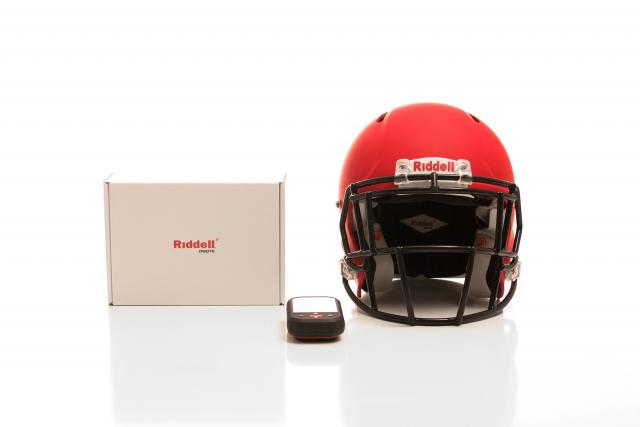Riddell InSite: Key Distinguishing Features
What makes Riddell InSite different from other impact response systems?
- The alerts are based on head impact, not helmet impact
- According to a recent research paper analyzing football helmets equipped with a version of the Head Impact Telemetry System (HITS) used in the InSite Impact Response System,1 HITS accurately measures head acceleration, which is less than 10 percent of helmet acceleration in football impacts.
- Grounded in research: It uses alert methodology based on over 2 million recorded on-field impacts using the Riddell SRS system.
- Uses HITsp for Alert thresholds, using a proprietary algorithm which takes into account linear and rotational acceleration, duration and location of impact.

- Identifies over-exposure of single as well as multiple impacts (seven day accumulation of significant impacts)
- Measures head impact on five key, distinct locations in helmet
- Has ability to program thresholds by player position and level of play:
- Player Position
- Quarterback
- Running Back
- Offensive Line
- Defensive Back
- Linebacker
- Defensive Line
- Special Teams
- Wide Receiver
- Level of Play
- Youth
- High School
- College
- Professional
- Player Position
- Designed to last up to four years with proper reconditioning (to replace battery)
1. Research paper. Manoogian S, McNeely D, Duma S, Brolinson G, Greenwald R. Head Acceleration Is Less Than 10 Percent Of Helmet Acceleration in Football Impacts.
Other sources:
Rowson S, Duma S. Brain Injury Prediction: Assessing the Combined Probability of Concussion Using Linear and Rotational Head Acceleration. Ann Biomed. Eng. 2013;41(5):873-882 @ notes 5,24,51,53.Rowson S, Brolinson G, Goforth M, Dietter D, Duma S. Linear and angular head acceleration measurements in collegiate football. J. Biomech Eng. 2009;131(6):061016.
Rowson S, Duma S, Beckwith J, Chu J, Greenwald R, Crisco J, Brolinson P, Duhaime A, McAllister T, Maerlender A. Rotational head kinematics in football impacts: an injury risk function for concussion. Ann. Biomed. Eng. 2012;40(1):1-13.
Crisco J, Fiore R, Beckwith G, Chu J, Brolinson P, Duma S, McAllister T, Duhaime A, Greenwald R. Frequency and location of head impact exposures in individual collegiate football players. J Athl. Train. 2010;45(6):549-559.
Crisco J, Wilcox B, Beckwith J, Chu J, Duhaime A, Rowson S, Duma S, Maerlender T, Greenwald R. Head impact exposure in collegiate football players. J Biomech Eng. 2011;44(15):2673-2678.
Duma S, Manoogian S, Bussone W, Brolinson P, Goforth M, Donnenwerth R, Greenwald R, Chu J, Crisco J. Analysis of real-time head acceleration in collegiate football players. Clin. J. Sport Med. 2005;15(1):3-8.
Funk J, Rowson S, Daniel R, Duma S. Validation of concussion risk curves for collegiate football players derived from hits data. Ann. Biomed. Eng. 2012;40(1):79-89.
Broglio S, Schnebel B, Sosnoff S, Shin X, Fend X, He, and Zimmerman J. Biomechanical properties of concussions in high school football. Med. Sci. Sports Exerc. 2010;42(11):2064-2071.
Broglio S, Sosnoff J, Shin X, He, Alcaraz C, and Zimmerman J. Head impacts during high school football: a biomechanical assessment. J. Athl. Train. 2009;44(4):342-349.
Daniel R, Rowson S, Duma S. Head impact exposure in youth football. Ann. Biomed. Eng. 2012;40(4):976-981.Mihalik J, Bell D, Marshall S, Guskiewicz K. Measurement of head impacts in collegiate football players: an investigation of positional and event-type differences. Neurosurgery 2007;61(6):1229-1235.
Pellman E, Viano D, Tucker A, Casson I, Waeckerle F. Concussion in professional football: reconstruction of game impacts and injuries. Neurosurgery 2003;53(4):799-812.
Rowson S, Beckwith G, Chu J, Leonard S, Greenwald R, Duma S. A six degree of freedom head acceleration measurement device for use in football. J. Appl. Biomech. 2011;27(1):8-14.
- 8052 reads
- Flag as offensive
- Printer-friendly version








